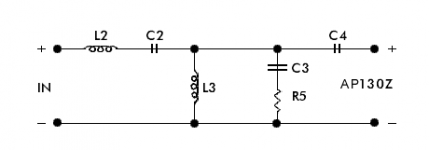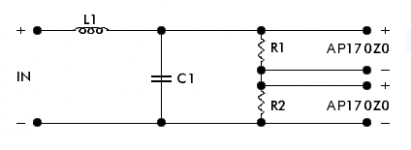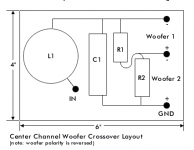Two quick questions for those of you (most of you) who know more about this stuff than I..
I'm finally getting around to building the center channel of the D'Appolito HT system based upon Audax drivers (I bought all of them necessary for the five channels many years ago, and have been enjoying the L and R speakers that I built fifteen years ago very much... great design). Another thread came up answering part of the question, but it only had one response, this is the internet, and... well... trust but verify.
Both of my questions concern the midrange crossover of the center channel.
1. In the schematic, it shows L2 as the first component encountered by the incoming positive signal, followed by C2 with no other components between them. The layout pictorial shows them in the opposite order.. C2 is first, followed by L2. In a series LC circuit, does it matter which component comes first if there are no other components between them? The other thread, from 2008, had one response indicating it did not matter, while the person asking the question had posted a quote from somewhere admonishing the builder to adhere to the schematic and NOT the pictorial.
2. The text from the original Audax webpages describes part of the circuit topology with the phrase, "C2, L3, and C7 make up a 3rd-order low-pass," but there is no C7 in the schematic, pictorial, or parts list. The text does NOT mention the existing C4 found in the schematic, parts list, and pictorial. Simply a typo, or is there a C7 missing from the schematic?
I attempted to contact Mr. D'Appolito directly using the @worldpath.net address at the end of his article, but it bounced... as one would expect after all of these years. Any help would be greatly appreciated!
Best to all..
I'm finally getting around to building the center channel of the D'Appolito HT system based upon Audax drivers (I bought all of them necessary for the five channels many years ago, and have been enjoying the L and R speakers that I built fifteen years ago very much... great design). Another thread came up answering part of the question, but it only had one response, this is the internet, and... well... trust but verify.
Both of my questions concern the midrange crossover of the center channel.
1. In the schematic, it shows L2 as the first component encountered by the incoming positive signal, followed by C2 with no other components between them. The layout pictorial shows them in the opposite order.. C2 is first, followed by L2. In a series LC circuit, does it matter which component comes first if there are no other components between them? The other thread, from 2008, had one response indicating it did not matter, while the person asking the question had posted a quote from somewhere admonishing the builder to adhere to the schematic and NOT the pictorial.
2. The text from the original Audax webpages describes part of the circuit topology with the phrase, "C2, L3, and C7 make up a 3rd-order low-pass," but there is no C7 in the schematic, pictorial, or parts list. The text does NOT mention the existing C4 found in the schematic, parts list, and pictorial. Simply a typo, or is there a C7 missing from the schematic?
I attempted to contact Mr. D'Appolito directly using the @worldpath.net address at the end of his article, but it bounced... as one would expect after all of these years. Any help would be greatly appreciated!
Best to all..
Can you post the schematic and text?
Sure.. Here's the text..
The midrange crossover has 2nd-order high-pass and 3rd-order low-pass characteristics. The topology is a bit unusual in that it does not resemble the traditional high-pass/low-pass cascade. Rather the topology is derived from a low-pass to band pass transformation. You can think of the 400Hz high-pass filter as being made up of L2, C3 and R5. This combination provides a 2nd-order response to compliment the 2nd-order woofer roll off. R5 controls the Q of the 2nd-order response. C2, L3 and C7 make up a 3rd-order low-pass. This electrical filter combines with the natural response of the midrange to produce an overall 4th-order in-phase high-pass response at 3500Hz.
And.. I've attached a snip of the midrange portion of the crossover. Thanks, both of you, for the responses.
Attachments
....In a series XX circuit, does it matter which component comes first if there are no other components between them?....
No.
Not limited to "LC" either.
The "no connection between" point is critical.
Since you folks have been so helpful, I've got another question that's a bit less "yes or no," at least I think it is. The woofer crossover in this speaker feeds a pair of woofers, and is second-order. There are two 10ohm resistors in the circuit specified to be rated at 25w. I can't find any "quality" resistors rated for 25w (Mills, Jantzen, Mundorf, etc).. only the standard cement-encased wirewound 75 cents-each type. I've attached a pic of the schematic for this part of the crossover, as well as a pic of the layout pictorial. As with my earlier question re/ the midrange portion of the XO, there is a discrepancy between the text, schematic, and pictorial. The text is as follows... a paste...
The low-pass filter comprised of L1 and C1 constitutes a second-order electrical network. Similar to the L/R speaker, resistors R1 and R2 equalize power sharing between the two woofers. Notice that the woofers are connected in reverse polarity as required for 2nd-order in-phase crossovers.
end paste.
The text refers to the need to reverse the polarity of the woofers for 2nd-order filters, and the pictorial layout shows that, but the schematic does not. Which is correct?
That's the first question.
The second one... how much does the quality of the resistors matter in the circuit, sound-wise? I found some Mundorf M-Resist 10 ohm resistors that are rated 20w, and cost about $15 each. Would that be worth it, and would 20w be sufficient even though the design specs 25w? If not, would the aforementioned el cheapo resistors be fine, or can you recommend other alternatives? Between the drivers, XO components, MDF, Russian Birch plywood, and a ton of construction time, I've got a lot wrapped up in this center speaker, so spending a few more bucks on two resistors wouldn't bother me if there was a commensurate improvement in sound quality. If not, cheaper is better. I'm guessing that it wouldn't matter as much in the signal path of the low frequency driver as it would in the mid or tweeter.. but I don't know much.
Thanks again for all the help.
The low-pass filter comprised of L1 and C1 constitutes a second-order electrical network. Similar to the L/R speaker, resistors R1 and R2 equalize power sharing between the two woofers. Notice that the woofers are connected in reverse polarity as required for 2nd-order in-phase crossovers.
end paste.
The text refers to the need to reverse the polarity of the woofers for 2nd-order filters, and the pictorial layout shows that, but the schematic does not. Which is correct?
That's the first question.
The second one... how much does the quality of the resistors matter in the circuit, sound-wise? I found some Mundorf M-Resist 10 ohm resistors that are rated 20w, and cost about $15 each. Would that be worth it, and would 20w be sufficient even though the design specs 25w? If not, would the aforementioned el cheapo resistors be fine, or can you recommend other alternatives? Between the drivers, XO components, MDF, Russian Birch plywood, and a ton of construction time, I've got a lot wrapped up in this center speaker, so spending a few more bucks on two resistors wouldn't bother me if there was a commensurate improvement in sound quality. If not, cheaper is better. I'm guessing that it wouldn't matter as much in the signal path of the low frequency driver as it would in the mid or tweeter.. but I don't know much.
Thanks again for all the help.
Attachments
Save your money!
40 OHM 5 WATT SAND | All Electronics Corp.
You need a 10-Ohm 25W resistor? If you paralleled 4 40-Ohm 5W resistors, it would give good selection/tolerance and a 20W power rating.
Or just one of these for $1! (10R 25W)
10 OHM 25 WATT CERAMIC RESISTOR | All Electronics Corp.
And with the money saved you can donate to diyaudio.com....
40 OHM 5 WATT SAND | All Electronics Corp.
You need a 10-Ohm 25W resistor? If you paralleled 4 40-Ohm 5W resistors, it would give good selection/tolerance and a 20W power rating.
Or just one of these for $1! (10R 25W)
10 OHM 25 WATT CERAMIC RESISTOR | All Electronics Corp.
And with the money saved you can donate to diyaudio.com....
Speaker is finished except for applying a nice finish to the cabinet. It sounds GREAT. Very excited. Thanks for all the help, folks. Ended up picking up two 10ohm 25 watt resistors that look suspiciously like the Mundorfs but at 1/4 the price at a local electronic supply place with a very knowledgeable proprietor. The woofer drivers are connected with the phase reversed as described in the text and pictorial, and not as depicted in the schematic. I did put the coil first in the input for the midrange, as depicted in the schematic. It's an amazing center channel design. Would be happy to post some pics if anyone is interested.
Glad you're happy with the sound!
My first ever DIY speaker was based on the Audax D'appolito design, converted to a 2 way, using just the AP130ZO and TW025F1, with the High pass elements removed from the Midrange crossover.
It's hard to believe, but it was probably 20 years ago.
I still have the one surviving speaker somewhere. Sadly the surrounds hardened slightly and Fs rose from 57 to 95Hz.
They still sound great.
My first ever DIY speaker was based on the Audax D'appolito design, converted to a 2 way, using just the AP130ZO and TW025F1, with the High pass elements removed from the Midrange crossover.
It's hard to believe, but it was probably 20 years ago.
I still have the one surviving speaker somewhere. Sadly the surrounds hardened slightly and Fs rose from 57 to 95Hz.
They still sound great.
- Status
- This old topic is closed. If you want to reopen this topic, contact a moderator using the "Report Post" button.
- Home
- Design & Build
- Construction Tips
- Crossover Question - D'Appolito Audax HT center


